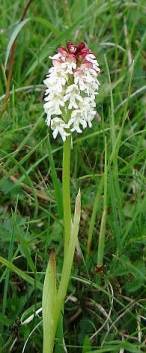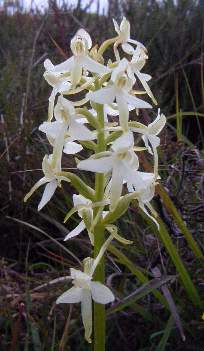Back to the Newsletter Contents and Home page
Botany Report 2003 (Reports for 2002)
by Gill Smith

Burnt-tip Orchid
Orchis ustulata
photo © Nan Sykes 2002 |
This year’s report is rather thin I’m afraid, since I did not have much time out and about, and did not receive many reports of interesting flowers. There were, however, three real highlights, and one tying up of loose ends from last year. The first highlight was the discovery of a burnt-tip orchid in flower on the limestone near Thorton-le-dale. This plant is rare, not only in Ryedale but in the whole country; indeed I have only ever seen it in Greece. As can be seen from the picture the plant gets its name from the very dark colour of the buds at the top of the stem even though these open to a delicate pale pink, with the individual flowers developing a manikin form.
The second highlight was the record from Martin Hammond: “shepherd’s needle (Scandix pecten-veneris), now a very scarce arable weed, was found in small quantities in winter wheat fields at Brawby and
Kedlholme”. The third was seeing Bladderwort flowering in Gilling Lakes, although admittedly only through binoculars as it was a long way from the bank!
And the loose ends? You may remember we had a record of gorse from Rudland that was “definitely not the common gorse, but I’m not completely convinced it’s western gorse (Ulex gallii) either! The jury is still out on this one.” The jury has now returned a verdict of U. gallii having had the chance to inspect the plant in full flower in 2002. |
For those of you who are interested in the minutiae, these are the differences, and the Rudland specimens clearly match the gallii characters (thanks to Nan Sykes):
| U. gallii | U. europaeus |
| hairs on calyx appressed | spreading hairs on calyx |
| bracteole distinctly smaller than stalk width | as wide or wider than stalk |
| spines slightly curved | quite straight |
| spines only faintly grooved | distinctly grooved |
| spines mildly sharp | spines fiercely sharp |
| mainly autumn flowering | mainly spring flowering |
We found over 80 plant species on our field trip to Eastmoors, almost 100 at Rudland including some fantastic orchids (see picture below right (© Adrian Smith 2002), and an astonishing 160 at Terrington; the full lists are available on the website (together with some photos). Other interesting plants were some very pale red dead nettles in agricultural land, also treacle mustard growing in the same fields. The bluebells were especially good in 2002, as was the hawthorn blossom.
Field Notes
Below is a (slightly edited) extract from my field notes for the year. It might be of interest to compare the dates of first flowering against last year’s which I presented in a similar format.
First week of January very cold and mostly foggy, so very little about, especially plants. Snowdrops showing white by 11th but none properly out till 21st. Very windy 28th.
First crocuses showing in Gilling 1st Feb. Mid-Feb warm and mostly sunny – everything put a
spurt on, so snowdrops at their best by about 12th Feb, also crocus. Daphne out by 15th (and the
first Chinodoxa). Dog’s mercury and celandine starting to show 14/15th.
Last week of Feb mostly windy, squally showers (often snow) with some warm sun. First daffodil
showing 28th/1st March. Primroses showing in Hovingham 5th March along hedge banks and
woodland edges. Forsythia also out first week of March. A few hawthorn bushes showing green by
about 10th, but then weather went cold again and things stopped. Daffodils in village about at best
21st, as was Forsythia.
 First blackthorn and windflowers showing ~25th March, primroses just coming to their best on
Sproxton Bank and round Hovingham. Some hedges showing a good deal of green, mainly
hawthorn. Blackthorn fully out by 2nd April, also primroses well out e.g. along towards
Hovingham.
First blackthorn and windflowers showing ~25th March, primroses just coming to their best on
Sproxton Bank and round Hovingham. Some hedges showing a good deal of green, mainly
hawthorn. Blackthorn fully out by 2nd April, also primroses well out e.g. along towards
Hovingham.
Stayed remarkably dry right through April, with warm sunshine but generally cool air. Windflowers
particularly good 3rd week, with wood sorrel coming. Few bluebells starting to show by 22nd.
Several clumps of red dead-nettle in Hovingham that were white or very pale pink – but with
darker markings so not albinos as such, though the leaves were paler than the normal purple
variety, all growing together. Also what I take to be Treacle mustard in a rape field, despite the
fact that the books say it shouldn’t flower till June! 23rd very warm and still dry; ground baking
hard. Wild cherries magnificent round about 25th, and bird cherries also coming.
Rained Friday 26th, also much colder again. Bluebells starting to show blue in the woods.
General “greening” about 28th April but ashes still bare mid-late May. Bluebells just coming to best 12th.
Bluebells very good mid-May, especially rich deep colour. Also probably the best year for
hawthorn blossom we can remember, with it all coming out together – at its best round about the
25th. Grass and verges very lush after all the rain.
11 June – Ryenats trip to Eastmoors. Lots of interesting plants in hayfield and wetland.
2 July – Ryenats trip to Rudland. Orchids including magnificent lesser butterfly and fragrant,
common and heath spotted and twayblade. Other goodies including petty whin, bog asphodel, bog
pimpernel, chickweed wintergreen and western gorse.
Start of August wet – grass and verges very tall and lush. 7th found wild toadflax, admittedly along
the verge of a track, at Hovingham. 12th Bladderwort in Gilling lake (only seen with binoculars!) flowering bright yellow. Also the
pondweed putting up flower spikes.
Mid-August: good showing of wild goldenrod in the verges between Coulton crossroads and
Hovingham. Last 2 weeks of August fine and dry, plenty of sunshine.
Early September wet, esp. Monday 9th. Tue 10th trip to Terrington, with >160 plants! 12th saw
dwarf spurge and probably small-flowered cranesbill (G. pusillum) in the corner of a cornfield at
Hovingham. Late Sept and first week of October sunny and dry, very pleasant. First frost 18-19th.
October wet towards the end, with strong winds 27th, making remaining plants very bedraggled.
November continued mostly mild but wet. Early December cold and easterly, mostly cloudy and
damp. Mid and late December cold, raw, easterly and mainly wet, leading to waterlogged fields.
Gill Smith February 2003
Back to the Newsletter Contents and Home page
© Ryedale Natural History Society 2003.
Site maintained by APL-385

 First blackthorn and windflowers showing ~25th March, primroses just coming to their best on
Sproxton Bank and round Hovingham. Some hedges showing a good deal of green, mainly
hawthorn. Blackthorn fully out by 2nd April, also primroses well out e.g. along towards
Hovingham.
First blackthorn and windflowers showing ~25th March, primroses just coming to their best on
Sproxton Bank and round Hovingham. Some hedges showing a good deal of green, mainly
hawthorn. Blackthorn fully out by 2nd April, also primroses well out e.g. along towards
Hovingham.